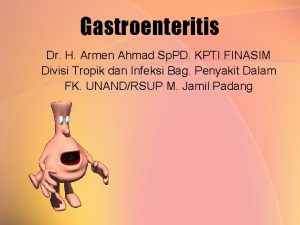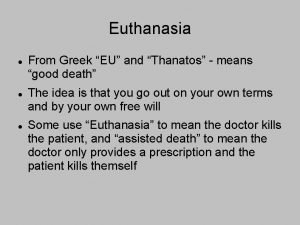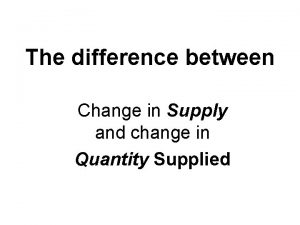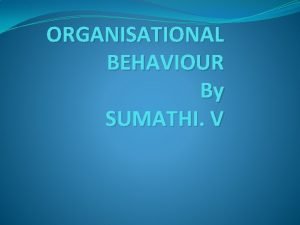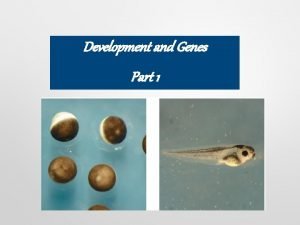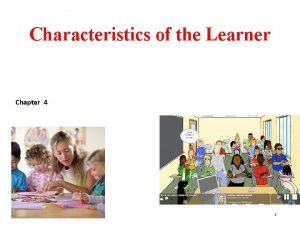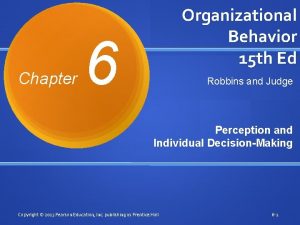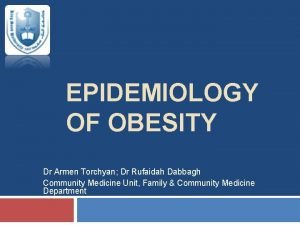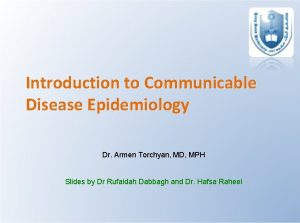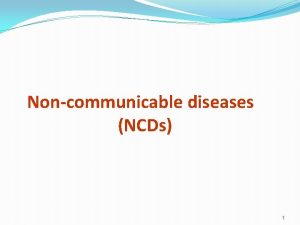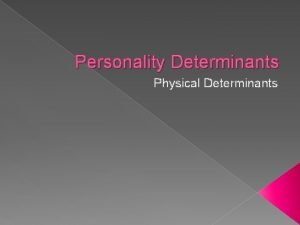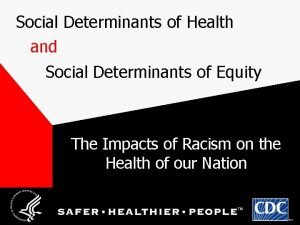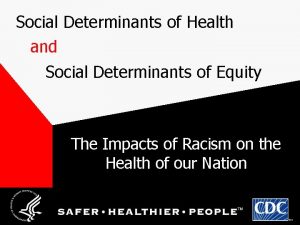Social Determinants of NCDs DR ARMEN TORCHYAN DEPARTMENT








































- Slides: 40

Social Determinants of NCDs DR ARMEN TORCHYAN DEPARTMENT OF FAMILY AND COMMUNITY MEDICINE

Objectives • Define the social determinants of NCDs • Discuss the significance, high risk groups and health consequences of social determinants of NCDs • Material conditions needed for individual and community well-being • The relationship between SES and health-risk behaviors • Psychosocial risk factors influencing NCDs • Neighborhood factors influencing NCDs • Evidence-based approaches to improving the social determinants of NCDs

Definition The social determinants of health are the conditions in which people are born, grow, live, work and age, and the wider set of forces and systems shaping the conditions of daily life. These forces and systems include economic policies and systems, development agendas, social norms, social policies and political systems.

47% of health outcomes

Ability to adhere is largely influenced by individual and contextual social factors Behavioral Source: http: //emro. who. int Multiple and interrelated causes

WHO: A conceptual framework for action on the social determinants of health

Powerful determinants of health Income Education Occupation Health - Differential exposure to conditions that have more immediate effects on health, such as access to healthy foods, a safe and clean place to live, and the ability to get routine physical exercise. - Those with less education and less income are more likely to smoke, less likely to engage in physical activity and less physically fit than their higher-income peers and are less likely to consume fiber and fresh fruits and vegetables. - Education promotes knowledge and life skills, which increase access to information and resources that promote health In addition, education builds occupational opportunities and earning potential, which in turn can lead to better nutrition, housing, schooling, and recreation.

Powerful determinants of health (cont. ) Education is more strongly related to the onset of illness and chronic conditions, and Income is more predictive of health trajectories and mortality after illness onset.

Intermediate determinants v Material circumstances include factors such as housing and neighborhood quality, consumption potential (e. g. the financial means to buy healthy food, warm clothing, etc. ), and the physical work environment. v Psychosocial circumstances include psychosocial stressors, stressful living circumstances and relationships, and social support and coping styles (or the lack thereof). v Behavioral and biological factors include nutrition, physical activity, tobacco consumption and alcohol consumption, which are distributed differently among different social groups. Biological factors also include genetic factors. v The health system plays an important role in mediating the differential consequences of illness in people’s lives.

Material Living Conditions § Food § Shelter § Transportation § Health care § Safe environments Socioeconomic status § Financial resources Higher rates of nearly every major health risk factor or health-damaging process Health inequities over the entire life course “impact of material and psychological stresses imposed by social inequities and marginalization is felt most intensely during perinatal/early childhood and puberty/ adolescent periods, when developmental genes are expressed and interact with social-physical environments. ” Furumoto-Dawson et al. (2007)

Health-Risk Behaviors Illicit drug use Obesity Physical inactivity Sexual risk taking Driving while intoxicated Not wearing a helmet others Risky Behavior Socioeconomic status Tobacco use

Psychosocial Risk Factors § Stress (both acute and chronic) traumatic life events coping and resilience self-efficacy self-esteem cynical hostility Hopelessness § Social relationships § § § social support social networks sense of job control experiences of discrimination use of risky behaviors as a form of self-medication Risk Factors § § § Socioeconomic status § Personality factors

Neighborhood Factors § the physical infrastructure and environment shared by residents, § including water, air, and street and sidewalk conditions § the level of risk in the environments in which people work, play, and rest § the quality of public and private services provided to residents, such as garbage removal, police protection, and social services § sociocultural features of neighborhoods, including norms, values, social cohesion, social networks, and civic engagement § the reputation of a neighborhood, which signals how it is perceived by residents and nonresidents, and involves shared community morale.

Neighborhood Factors - Many features of the built environment and urban design (including land-use patterns, sidewalks, transportation systems, and street connectivity) are associated with physical activity and other features of mobility important to health. - Neighborhood features such as the absence of grocery stores and the types of food available are associated with dietary features and obesity rates across communities. - One U. S. study found that features of urban food deserts, such as distance between stores and prices, were associated with obesity, and that price was the main driver of this relationship. - Above and beyond the individual characteristics of residents, neighborhood characteristics produce both positive and negative impacts on health behaviors, health status outcomes, and health inequities.

Reverse Causality Socioeconomic position NCDs

Pathophysiology

The Whitehall study demonstrated an inverse relationship between social status and coronary heart disease (CHD) mortality among middle aged British men with stable employment, such that those with lower social status based on occupation had higher rates of mortality; this association remained even after controlling for potential behavioral and laboratory-based confounders. Lack of material goods, health behaviors, illiteracy, or access to quality health care ? ? ?

Allostatic load § Allostasis refers to fluctuations in physiologic systems within the body to meet the demands of external stressors. § Allostatic systems allow individuals to respond to a broad range of stressors, not only biologic, such as infection or injury, but also to those stressors that may fall into the category of social determinants of health. § The body’s response to any stressor should involve both turning on an allostatic response and turning off the response once the stressor has passed. § Over time, the “wear and tear” that accumulates as a result of the chronic overactivity or underactivity of allostatic systems is referred to as the allostatic load.

Mc. Ewen, B. S. (2016).

Mc. Ewen, B. S. (2016).

Mediators of allostasis involved in the stress response Mc. Ewen, B. S. (2016).

Brain regions that remodel dendrites and synapses. Mc. Ewen, B. S. (2016).

Allostatic load (cont. ) § A population-based, longitudinal study in the United States found that negative life events and other types of stressors were more common in lower socioeconomic strata. § Decreased ability to change risk behaviors - helplessness, hopelessness, fatalism, low selfesteem, alienated labor, hostility, anger, and passive coping. § “rooted and shaped by adverse socio-economic conditions during upbringing and adulthood, and. . . are related to adverse health outcomes through complex psychological, behavioral and biological pathways”

Childhood stressors - neuroplasticity Childhood stressors during development Changes in the structure and function of the limbic brain Affected neuroplasticity § Can affect patterns of emotional expression and regulation, stress reactivity, recovery, coping, and perhaps even bodily aging § May affect an individual’s ability to process new information and make decisions on how best to approach challenges § Can potentially lead to elevated HPA activity and repeated stresses through a glucocorticoid cascade § Change in major regulatory system parameters, including cardiovascular, metabolic, and inflammatory system parameters

Childhood stressors - neuroplasticity § Early childhood stress and exposure to disadvantage establishes a health trajectory that is difficult for an individual to change despite subsequent upward social mobility. § Independent of adult SES, childhood SES has been shown to predict blood pressure. § There has also been a suggested association with low SES in childhood and diminished cortisolmediated signaling through adulthood, which in turn facilitates excessive inflammatory responding in cells of immune system and excessive cortisol release by the HPA axis. § Inflammatory markers were found to be higher among adults who had low SES as children, even after controlling for adult SES § Among British adult women, parent’s occupation status more was found to have a greater impact on insulin resistance, dyslipidemia, and obesity than adult occupation status

Discrimination and Stress § Self-reported experiences of discrimination on the basis of on race, ethnicity, and social class demonstrates significant associations with a number of health outcomes. § The research literature is most developed in the case of perceived racial/ethnic discrimination and mental health disorders (i. e. , depression, anxiety disorders) and the physical health outcomes of hypertension and low birth weight.

Key Interventions


Baird et al, 2017

Improving health “Despite an increasing awareness about the social determinants of health, many people still believe that health is largely improved by reducing unhealthy behaviors and increasing access to health care” Remington PL (2010)



Education Early childhood education is associated with: § improved graduation rates and earnings § improved adult health status § lower behavioral risk factors § lower criminal activity


Employment and Income § Improved financial security § Social status § Personal development § Social relations § Self-esteem § Protection from physical and psychosocial hazards § Access to health care § Safe houses and neighborhoods § Healthy and affordable foods § Time and safe space for physical activity


Fair Employment and Decent Work § Full and fair employment and decent work as a national policy agenda. § Strengthened representation of workers in the creation of policy, legislation, and programs relating to employment and work. § Provide quality work for men and women with a living wage that takes into account the real and current cost of healthy living. § Protect all workers. § Implement core labor standards formal and informal workers. § Develop policies to ensure a balanced work-home life. § Reduce the negative effects of insecurity among workers in precarious work arrangements.

Housing access and quality

Equity from the start “Each one of you is your own person, endowed with rights, worthy of respect and dignity. Each one of you deserves to have the best possible start in life, to complete a basic education of the highest quality, to be allowed to develop your full potential and provided the opportunities for meaningful participation in your communities. ” Nelson Mandela and Graça Machel (UNICEF, 2000)

References Mc. Ewen BS. Chapter 5 - Central Role of the Brain in Stress and Adaptation: Allostasis, Biological Embedding, and Cumulative Change. In: Fink G, editor. Stress: Concepts, Cognition, Emotion, and Behavior. San Diego: Academic Press; 2016. p. 39 -55. CSDH (2008). Closing the gap in a generation: health equity through action on the social determinants of health. Final Report of the Commission on Social Determinants of Health. Geneva, World Health Organization. Remington PL, Brownson RC, Wegner MV. Chronic Disease Epidemiology, Prevention, and Control, 4 th edition. Washington, DC: American Public Health Association; 2016.
 Merits and demerits of takhtajan classification
Merits and demerits of takhtajan classification Armen yuri gasparyan
Armen yuri gasparyan Dr armen ahmad
Dr armen ahmad Armen mnatsakanian
Armen mnatsakanian Euthanasia greek
Euthanasia greek Gebouwinspectie met drone
Gebouwinspectie met drone What are the 6 main social determinants of health?
What are the 6 main social determinants of health? Social determinants of personality
Social determinants of personality Social determinants of aggression
Social determinants of aggression Social thinking and social influence in psychology
Social thinking and social influence in psychology Social thinking social influence social relations
Social thinking social influence social relations What are the determinants of market structure
What are the determinants of market structure Acdc copyright
Acdc copyright Non price determinants of supply
Non price determinants of supply Non price determinants of supply
Non price determinants of supply Non price determinants of supply
Non price determinants of supply Examples of substitute goods
Examples of substitute goods What are the determinants of market structure
What are the determinants of market structure Color 23112006
Color 23112006 Pes determinants
Pes determinants In the sobc model o represents
In the sobc model o represents Matrix multiplication definition
Matrix multiplication definition Determinants of staffing choices
Determinants of staffing choices What are the 5 determinants of price elasticity of demand
What are the 5 determinants of price elasticity of demand Demand analysis example
Demand analysis example What are the 5 determinants of price elasticity of demand
What are the 5 determinants of price elasticity of demand Cytoplasmic determinants
Cytoplasmic determinants Determinant of gait
Determinant of gait Delivered value
Delivered value What are the determinants of market structure
What are the determinants of market structure What are the determinants of market structure
What are the determinants of market structure Experiential readiness examples
Experiential readiness examples Determinants of attribution theory
Determinants of attribution theory Adjoint of a 2x2 matrix
Adjoint of a 2x2 matrix Chapter 16 determinants of the money supply
Chapter 16 determinants of the money supply Chapter 16 determinants of the money supply
Chapter 16 determinants of the money supply Determinants of supply
Determinants of supply Applications of matrices and determinants
Applications of matrices and determinants Cramer's rule 3 by 3 matrix
Cramer's rule 3 by 3 matrix Multiplication of determinants
Multiplication of determinants Determinants socials de la salut
Determinants socials de la salut


